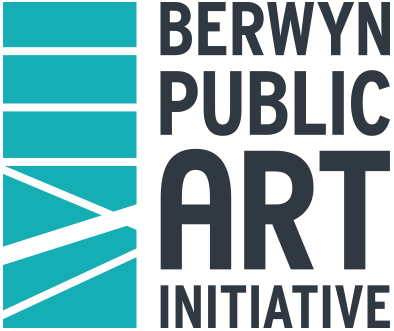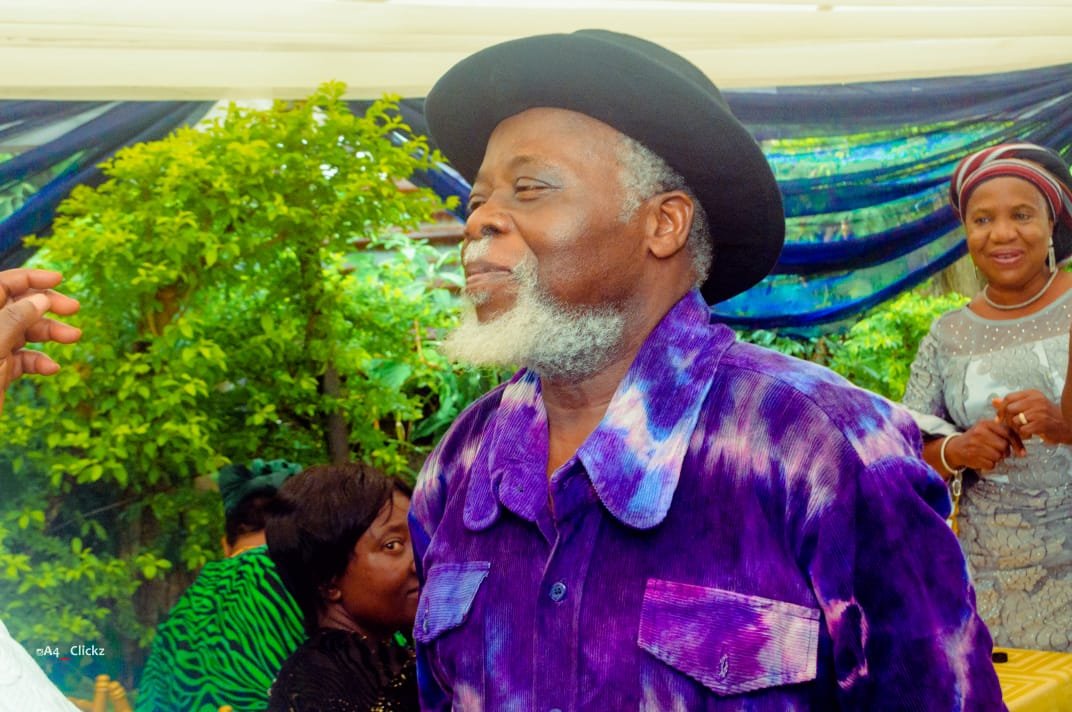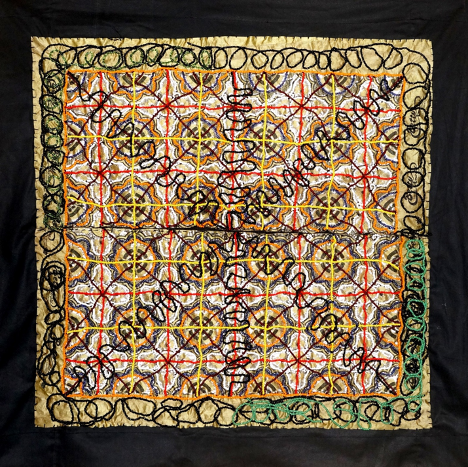Tunde Odunlade
It is our pleasure to introduce Nigerian-based interdisciplinary artist, Tunde Odunlade who is featured in the Community Art Collection. While his specialty is in batik textile and fiber arts, he also fosters an art community as a gallery owner supporting local artists and collaborating in creative endeavors with his immediate community and institutions internationally. In addition, he is a musician and has been featured in theatrical and film productions.
The intricacy found in Tunde’s tapestry titled Ikorita (Intersections) consists of a delicate dance between the various fabrics used, hundreds of colorful beads that create a maze of hard & organic lines throughout, and hand stitches that ground the artwork. The scale of the work is also impressive and greets viewers with memorable details. While Tunde Odunlade is based in Nigeria, he has representation in Chicago through the creative agency Golden Our Collective which fosters culturally diverse black artists.
“Art, a tool for effective communication, it’s always at the threshold of history.”
ARTIST Q&A
A conversation between Michelle Ruiz and Tunde Odunlade
Michelle Ruiz: Tell us a little about your background and what led you to the arts.
Tunde Odunlade: You see, the answer is simple and straightforward; The truth is, Art chose me.
How? I was born into a Royal family of Ile-Ife (Origin of the Yoruba People) in Osun State Nigeria, South Saharan part of Africa, and any child born in that clime, if a male child gets his name and panegyrics or Orature “Oruko and Oriki” respectively, on the eighth (8th) day while a female child gets named on the seventh (7th) day, according to my Royal Family (Odogbon Compound Ruling House) Custom. Every name and orature given to me on that day is exactly what my journey through has hinged upon. Even though I wasn’t even conscious of it until much later in life when I’d already become an established successful practicing artist.
My own name and orature: “Tunde” is short for Babatunde, my first name, it translates to Father has come back again. I was born after the passing of my grandfather, so it is believed that my grandfather has returned to me, reincarnation I suppose. I was told my grandfather was a very creative person informally but was a farmer professionally.
The orature: L’adire means, One who makes or owner of Adire. Adire is the Indigo batik textile of the Yoruba people of Nigeria made out of Cassava wax. Batik is Javanese (now Indonesia) name meaning “To wax and dye.”
Lo and behold today, my specialty is Batik Textile/fiber art, which has now metamorphosed into relief batik, batik quilt tapestry, beaded damask tapestry, beaded quilt tapestry, and currently beaded batik quilt tapestry.
My background in the arts also includes being an apprentice to Nigerian artist, Adeyinka Adeyemi for 18 months. In addition, I enrolled in an experimental art workshop under the Auspices of the University of Ife (now Obafemi Awolowo University) Ile Ife. During these two significant experiences, I studied paintings, and printmaking (linoleum and woodcut prints, etching, monoprint, drawing from the back.
I also attended several art classes in Nigeria USA, Europe, Canada, and other parts of Africa working with many artists. I have engaged in exchange programs from abroad and have invited artists to my studio in Nigeria such as Caryl Henry from Washington DC and Jeff Gleuser from Atlanta GA. I have also worked in various universities as visiting professor and artist in residence.
MR: We are thrilled to have one of your hand-beaded demask tapestries titled Ikorita (Intersections) in this collection. There is rich intricacy and layering in your beading technique. Can you tell us about the inspiration behind this piece, how long it took to complete, and your approach to this type of work?
TO: The piece “Ikorita” is a Yoruba proverb that actually means intersection. The full sentence is “__Ikorita nii da mu alejo__” a person you once met at an intersection, and you do not know the person's precise address, and now you are trying to reconnect with the person, it might be a bit complicated, as you need to have some description to the person’s house or office address if you must locate the person. Like the saying; “if you must find your way, first you must know where you are going, and if you don’t know where you are going, any road will do”.
“Ikorita” is a piece I love so much and I always recommend the morale in it, to settle rifts. The multi-layers in it depict how every matter could have multi layers and could be complicated, but your approach matters a big deal.
This piece took about two to three months to complete. My approach to this work is such that I knew what I was looking for; however, I wanted the process to lead the way, like a kind of serendipity.
MR: What drew you to tapestry and are there other mediums that you employ?
TO: I was trained first and foremost as a batik artist from the inception of my training. What is batik? Batik is a piece of cloth or any type of fiber material waxed and dyed, and it comes in the form of a painting. In other words, it’s a method of wax resistance against dye or any form of coloration. In Mali and some other parts of West Africa, they wax and dye beads, and it‘s usually monochromic by nature.
In 1987, I had my first solo show in a Bronx, New York gallery called Gallery 69. After the duration of the show, the remainder of the Batik pieces were kept in the Basement of the gallery. I showed up at the gallery one day and was given the sad news that the gallery owner’s cat had pierced and made a hole into my precious batik piece. I cried when I saw it, but something told me immediately that tears will not wash off the damage. Getting home that evening, my friends' roommates/hosts Mitch and Kim noticed that I wasn’t quite myself, because every night we played Chinese Checkers and I always beat them, but that night they beat me several times. So they became curious and apprehensive about what happened, and I explained to them, and they were quite sympathetic. We started ruminating together over it till each one went into their room.
Soon as I entered my room, I just got the wind that laying different fabrics of different weights and different textures and even if different colors on to top of each other additively and perforating some of them and now stitch them together till I have heavy layers of fabric to work on and the same batik methodology is still applicable to it but now cannot be easily torn by any form of attack as I’ve experienced from the claws of that cat.
I quickly went and woke my friends up in the middle of that night with my sudden discovery of my new method. We began by using pieces of paper to demonstrate what it could be like.
No more sleep from there on till we came to a logical conclusion. As soon as I returned to Nigeria, I went straight into the studio to put that new idea into practice, the first piece was breathtaking. This medium has now grown into various stages from what I nicknamed recycled Batik, but my Professor at Iowa State University Prof. Norma Wolff of the Anthropology dept, cautioned that I should not call it Recycled Batik but instead call it Relief Batik. At a point, I started using found fabrics, discarded fabrics, family-used clothing, remnants from fashion homes, and other sources.
As a matter of fact, Aljezera Television visited my gallery first on world environmental day to feature my works and other artists who make their art from would-have-been waste materials that we turn now into treasures. To save our planet. We call it from “waste to wealth”
This medium has grown more and more beautiful and has now metamorphosed into beads and other objects incorporated into it, as well, which is now called Beaded Batik Quilt Tapestry. Like the piece, you have in your collection now, “Ikorita” Beade Damask Tapestry.
MR: Are there specific conversations you are looking to bring forth through your art practice?
TO: I describe my work as ‘Art with a purpose’ as opposed to “Art for art’s sake” I believe that it's not art if it fails to heal, to communicate, to inform, to speak, to affect, and to educate, I say ‘art is an effective means of communication and art is always at the threshold of history.’ my motto is “he who does attempt the absurd, can never achieve the impossible.”
While I equally share Pablo Picasso saying that “Art is a lie that makes us see the truth” and “a line is a dot that went for a walk” Paul Klee.
Therefore, my art is special to me as it enables me to have the audacity in saying things as they were, without fear or fervor stemming out of my freedom of Artistic imperatives. The Ministers of God: will call it the “Prophetic Imperative.”
MR: In addition to your art practice, I understand that you foster other artists in a gallery space that you own and manage. Can you tell us more about your involvement in your local art community?
TO: Art in my Community is a way of life, art is an integral part of our life. We have a lot of different ethnicities that have made our arts and cuisine so rich that any serious artist who allows his environment to impact his or her creativity, that artist will be like “a kid let loose in a candy store” because you have unlimited subjects to draw from, thereby expanding your scope to grow wider and making your vocabulary more voluminous.
The gallery that I run is a multi-dimensional space given to different genres of art practice ranging from music to drama, dance, poetry, symposium, a conference to visual art aiming at raising awareness that has now given us the reputation of being a community center which I’m really glad about.
Many established artists get showcased, and a lot of young folks get to carve a niche for themselves in whatever art career they may have chosen. I look forward to opportunities to have grants that can really enable us to do more than we are currently doing without having to struggle. I have a staff force of fifteen, including myself. At the moment, the funds to support these laudable worthwhile projects come out of my meager resources and the proceeds from my art sales here and there.
MR: Are there other places in the States where someone can purchase your work or see it in person?
TO: My work can be found in a number of collections, which include museums, institutions, universities, and private collections which include: Smithsonian, National Museum of African Art, and Museum of International Folks Arts. (MOIFA), Museum of Fine Arts (MFA) St Petersburg, FL, Santa Fe College of Arts and Design Santa Fe New Mexico, Schomburg Center for Research in Black Culture New York, Palo Alto College San Antonio, Texas, Bowie State University Bowie, Maryland, Hammonds House Museum Atlanta, G, Northern Illinois University (NIU), Jordan National Gallery of Art Amman, Jordan and Victoria & Albert Museum London to name a few.
Artist Information
Tunde Odunlade
IG: @tundeodunlade
Email: hello@goldenourcollective.com
Click here for the catalog to view the Community Art Collection currently on display at Baird & Warner.


